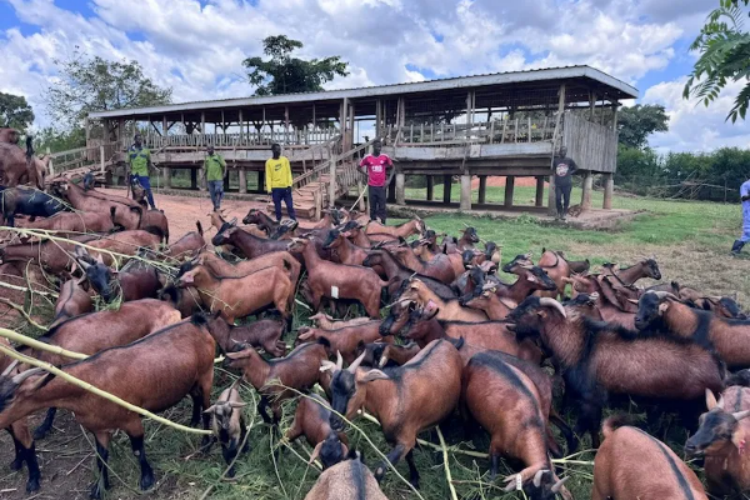By Ssenkayi Marvin Ezra
The National Animal Genetic Resources Centre and Data Bank (NAGRC&DB) has introduced a new goat breed—the Kasolwe Brown Goat—which experts believe could position Uganda as a leading exporter of goat genetics and meat in sub-Saharan Africa.
Developed through years of selective breeding at the Kasolwe Stock Farm in Kamuli District, the Kasolwe Brown is entirely derived from indigenous genetics. A foundation herd of more than 500 goats now breeds “true to type,” consistently passing on superior traits.
Dr. Katali Benda, head of the goat breeding programme, described the breed as “a game-changer” thanks to its adaptability to diverse agro-ecological zones, high reproductive capacity, and potential to boost farmers’ incomes.
Farmers already working with the breed report impressive outcomes. The Kasolwe Brown grows rapidly, achieving daily weight gains of up to 127 grams. Mature females weigh up to 65 kilograms, while males reach as much as 75 kilograms—well above most indigenous breeds.
The goats are also remarkably hardy, showing resistance to common diseases such as Haemonchosis and Heartwater. Their glossy brown coats with black manes provide natural protection against parasites.
Local farmers affirm the breed’s value, with Mr. Tefula noting its rapid growth with minimal supplementation, Mrs. Kamaali praising its high twinning ability that boosts herd size, and Mr. Mutiibwa highlighting lower veterinary costs from its tolerance to local parasites and diseases.
With large udders, females can comfortably nurse twins and even triplets without supplementary feeding—significantly boosting herd growth within a short period.
Dr. Ssengoye Gordon, NAGRC&DB’s Technical Manager of Production, emphasised that the Kasolwe Brown offers a viable local alternative to exotic breeds like Boer or Kalahari, which require expensive feed and intensive care. “This breed eliminates the need for imports while delivering superior productivity,” he said.
Comparative studies against Boer, Savannah, Kigezi, Mubende, and Kalahari breeds confirmed the Kasolwe Brown’s advantages in twinning, growth, adaptability, and disease resistance.
The breed’s popularity has created new challenges, with male breeding stock in such high demand that NAGRC&DB has deployed armed guards to prevent theft. To expand access, the organisation is partnering with Kasombereza Farm Solutions to establish the Kasolwe Goat Breed Society, which will oversee multiplication and nationwide distribution.
The rollout will complement government initiatives such as the Parish Development Model and Emyooga, ensuring that smallholder farmers—the backbone of Uganda’s livestock sector—are the primary beneficiaries.
NAGRC&DB Executive Director, Dr. Peter Beine, is optimistic about the breed’s impact: “With adequate support, Uganda can dominate the export of goat genetic resources in sub-Saharan Africa.”
The Kasolwe Brown has already attracted global attention. Researchers from Makerere University and the University of Edinburgh’s Roslin Institute are studying its genetic traits and disease resistance, with plans to conserve these features in gene banks for future generations.
For rural households, the benefits are immediate. Goats provide meat, milk, and income—and a breed that combines resilience with productivity could be transformative. By reducing dependence on costly imports, farmers adopted the Kasolwe Brown stand to increase local meat and milk supplies while tapping into lucrative regional and international markets.
As Dr. Benda emphasised, the Kasolwe Brown Goat is more than a livestock innovation—it is a homegrown solution tailored to Uganda’s realities. Its success, however, will depend on sustained breeding support, farmer training, and equitable distribution.
For now, the enthusiasm amongst farmers and scientists alike suggests Uganda’s new “super goat” is well on its way to reshaping the livestock industry.


